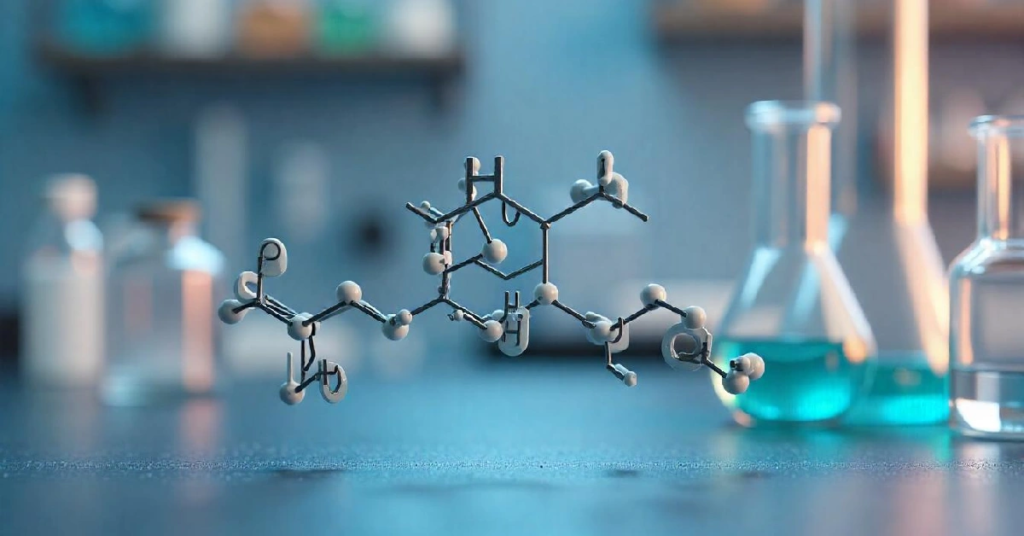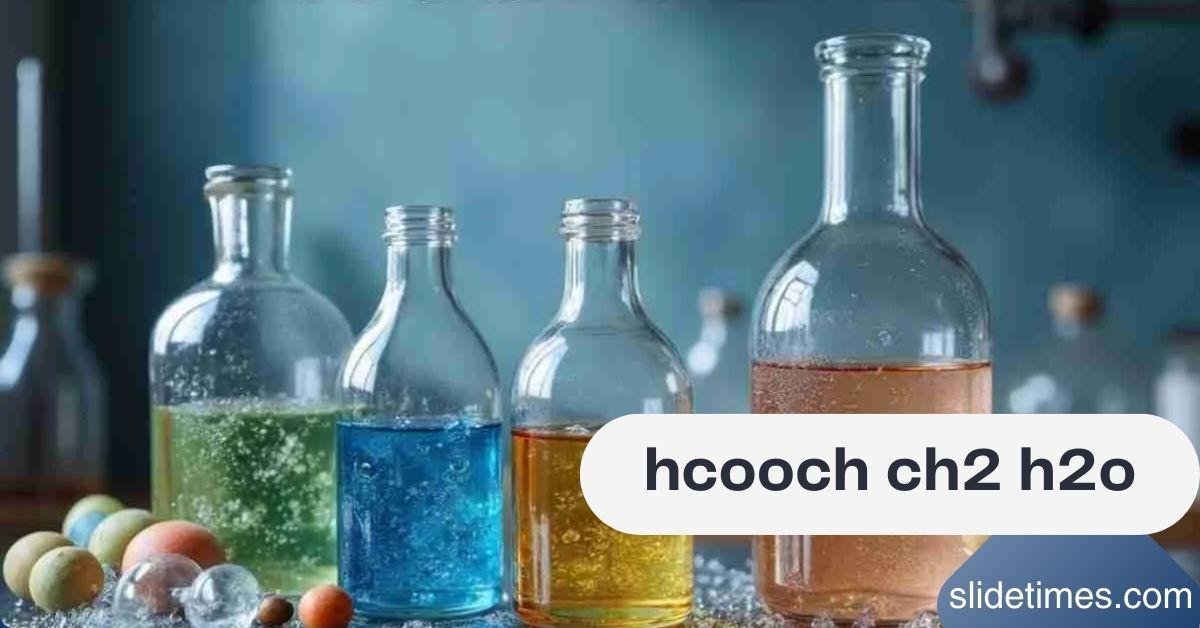If you’ve ever come across the chemical formula hcooch ch2 h2o, you may have wondered what it means. This combination involves methyl formate (HCOOCH3), methylene (CH2), and water (H2O). These are important components in organic chemistry with powerful roles in chemical reactions, industrial uses, and even green chemistry solutions.
This article is designed to explain everything about hcooch ch2 h2o in a simple and comprehensive way. Whether you’re a student, a chemistry enthusiast, or someone working in industry, this guide will give you a deep understanding of the chemistry, reactions, applications, safety, and future potential of these substances. By the end, you’ll see how this combination is relevant to many parts of everyday life and cutting-edge science.
What Is HCOOCH CH2 H2O?
Breaking Down the Formula
To fully understand hcooch ch2 h2o, it’s important to look at each part:
- HCOOCH3 (Methyl Formate): This is an ester formed from formic acid and methanol. It has a sweet smell, is colorless, and highly volatile. It is used in solvents, adhesives, and even as a blowing agent for foams.
- CH2 (Methylene Group): Methylene is a group that contains two hydrogen atoms bonded to one carbon. It is commonly found in organic molecules and is known for forming double bonds or acting as a reactive intermediate.
- H2O (Water): Water is not just a common liquid but also a vital participant in countless chemical reactions, including hydrolysis and condensation reactions. It is a universal solvent that enables reactions to occur more efficiently.
The formula hcooch ch2 h2o is not just symbolic but points to possible interactions between these components in various chemical settings, including laboratory experiments and industrial applications.

The Chemistry Behind HCOOCH CH2 H2O
How They React Together
When methyl formate, methylene, and water are mixed, several reactions can occur depending on conditions like temperature, pressure, and the presence of a catalyst. Common reactions include:
- Hydrolysis of Methyl Formate: Water can break down methyl formate into methanol (CH3OH) and formic acid (HCOOH).
- Addition of Methylene Group: The CH2 group may participate in polymerization or chain-extension reactions with esters like methyl formate.
- Formation of Complex Organic Compounds: In the presence of catalysts, these components may form aldehydes, alcohols, or longer chain esters.
Role of Catalysts
The presence of an acid (like HCl or H2SO4) or a base (like NaOH) can greatly speed up these reactions. Catalysts do not get consumed in the reaction but help to lower the activation energy and drive the reaction forward.
Also Read: Crackstreams 2.0: The Complete Guide for Sports Streaming Fans Worldwide
- Acidic Medium: Promotes hydrolysis and esterification.
- Basic Medium: Promotes saponification and nucleophilic substitution reactions.
Understanding these reactions allows chemists to manipulate the mixture to produce desired products efficiently.
Applications of HCOOCH CH2 H2O in Real Life
In the Chemical Industry
Methyl formate is widely used in the chemical industry, often in combination with water and methylene groups:
- Solvent Use: Due to its low toxicity and fast evaporation, methyl formate is ideal for use as a solvent in paints, coatings, and adhesives.
- Intermediate in Chemical Synthesis: It acts as a building block for creating formic acid, methylal, and dimethylformamide (DMF).
- Blowing Agent in Foams: Used to produce foam insulation and packaging materials, replacing ozone-depleting substances.
In Pharmaceuticals
- Synthesis of Intermediates: HCOOCH3 is used to create important intermediates that are precursors to drugs such as antibiotics and anti-inflammatory medications.
- Controlled Release Formulations: The reaction of HCOOCH CH2 H2O can help form compounds used in slow-release drug formulations.
In Green Chemistry
- Eco-Friendly Solvent: Methyl formate is considered environmentally friendly compared to petroleum-derived solvents.
- Renewable Sourcing: It can be produced from biomass, making it a sustainable chemical option.
- Reduced Emissions: Reactions involving these compounds produce fewer harmful emissions compared to traditional chemical processes.
Benefits of Using HCOOCH CH2 H2O
Safety
- Low Toxicity: Methyl formate is safer to handle than many industrial solvents.
- Non-Corrosive: Unlike stronger acids or bases, these chemicals are not overly corrosive.
- Biodegradable: Breaks down naturally in the environment, reducing long-term ecological damage.
Also Read: Influncersgonewild: The Bold Social Media Trend Changing Online Culture
Versatility
- Wide Use Range: From foams and resins to pharmaceuticals and solvents.
- Easily Modified: The structure of these compounds allows for easy chemical modifications to meet specific needs.
Sustainability
- Green Chemistry Goals: Aligns with principles of green chemistry like reducing waste and using renewable feedstocks.
- Cleaner Reactions: Produces fewer hazardous byproducts.
Scientific Insight: How Reactions Happen
Mechanism of Hydrolysis
- The water molecule attacks the carbon atom in the ester group of methyl formate.
- The ester breaks into formic acid (HCOOH) and methanol (CH3OH).
- A methylene group may then bond with either product to form larger molecules.
This mechanism is fundamental in organic chemistry and forms the basis for understanding more complex biochemical pathways.
Example Reaction
Let’s take a reaction:
HCOOCH3 + H2O → HCOOH + CH3OH
Now introduce a methylene group:
CH2 + HCOOH → CH2(HCOOH)
This is a simplification, but it demonstrates the concept of how these molecules can combine to form new and useful products.
Challenges in Working With HCOOCH CH2 H2O
Reaction Control
- Precise Conditions Required: Temperature, pH, and concentration must be carefully controlled.
- Side Reactions: Uncontrolled conditions can lead to unwanted products, lowering the efficiency and safety of the process.
Storage and Stability
- Flammability: Methyl formate is highly flammable.
- Volatility: Evaporates quickly and must be stored in sealed containers.
- Reactivity with Air and Moisture: Must be kept away from open air and moisture to maintain stability.
Laboratory Uses
As a Reactant
In laboratory settings, hcooch ch2 h2o mixtures are used in organic synthesis to create aldehydes, alcohols, and carboxylic acids. These reactions are crucial for understanding fundamental organic chemistry principles.
In Educational Labs
- Demonstrations of Hydrolysis: Methyl formate hydrolysis is a common experiment in college-level chemistry.
- Teaching Catalysis: Students learn how different catalysts affect reaction rates and products.
Industrial Case Studies
Foam Production
One of the most important applications of methyl formate is as a blowing agent in foam manufacturing:
- Polyurethane Foams: Used in construction and automotive industries.
- Eco-Friendly Alternative: Replaces chlorofluorocarbons (CFCs), which harm the ozone layer.
Pharmaceutical Manufacturing
Companies use HCOOCH3 reactions to synthesize drug intermediates:
- Antibiotic Precursors: Helps in producing building blocks for drugs.
- Pain Relievers and Anti-inflammatory Drugs: Involved in key reaction steps.
Also Read: soa os23: A Complete Guide for Everyone
Environmental Impact
Positive Effects
- Biodegradable: Breaks down in soil and water naturally.
- Low VOC Emissions: Helps industries meet environmental regulations.
- Green Chemistry: Suitable for sustainable chemical manufacturing.
Concerns
- Improper Disposal Risks: Must be handled as chemical waste to avoid water pollution.
- Fire Hazard: Highly flammable, requiring careful storage and transport.
How to Handle HCOOCH CH2 H2O Safely
Storage Tips
- Airtight Containers: To prevent evaporation and moisture contact.
- Cool and Dry Environment: Minimize the risk of ignition and degradation.
Personal Safety
- Wear Protective Gear: Gloves, goggles, and lab coats.
- Work in Ventilated Areas: Fumes from methyl formate can be harmful.
Disposal Methods
- Follow Local Laws: Always dispose of according to hazardous waste regulations.
- Avoid Drains: Never dispose of into sinks or open water.
The Future of HCOOCH CH2 H2O in Chemistry
The future is bright for these compounds due to increasing demand for sustainable and safe chemicals. Ongoing research areas include:
- New Catalyst Development: For faster and cleaner reactions.
- Biotechnology Applications: Using these compounds in metabolic engineering and drug synthesis.
- Industrial Scaling: Making green alternatives competitive with traditional petrochemicals.
Scientists are working on ways to produce methyl formate from CO2 and hydrogen, turning a waste gas into a valuable product.
FAQs About HCOOCH CH2 H2O
What is HCOOCH CH2 H2O exactly?
It refers to the chemical interaction or mixture of methyl formate, methylene, and water. They are used in many types of chemical reactions and industrial applications.
Is HCOOCH CH2 H2O dangerous?
It is generally safe when used properly. However, methyl formate is flammable and should be handled with care using appropriate safety measures.
Can it be used in green chemistry?
Yes. Methyl formate is biodegradable and can be derived from renewable sources, making it suitable for eco-friendly applications and sustainable industrial processes.
Where is it used in everyday life?
You can find products made using these chemicals in foam cushions, insulation materials, cleaning agents, paints, and even in the pharmaceutical industry.
What happens when HCOOCH CH2 H2O reacts?
Usually, methyl formate breaks down with water to form methanol and formic acid. The methylene group may then combine with these or other molecules to form more complex organic compounds.
Is methyl formate a natural or synthetic compound?
It can be both. While usually produced synthetically in factories, it is also found in some fruits and as a byproduct of fermentation.
Final Thoughts
The chemical combination of hcooch ch2 h2o is more than just a formula. It’s a gateway to modern, sustainable chemistry. Its role in industry, research, and the environment shows how essential these compounds are to our daily lives.
From manufacturing to green science, the interaction of methyl formate, methylene, and water is helping shape the future. Whether you are a student or a scientist, understanding this chemistry opens the door to more responsible and innovative uses of chemicals that protect both people and the planet.
